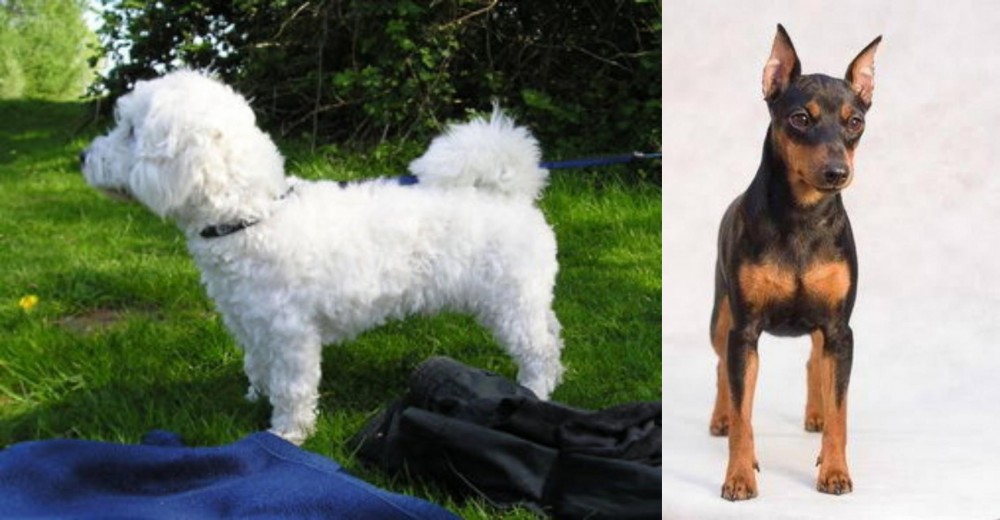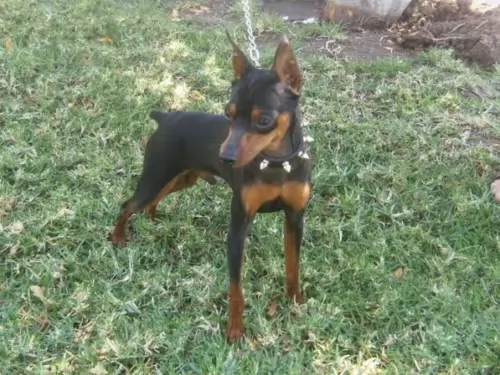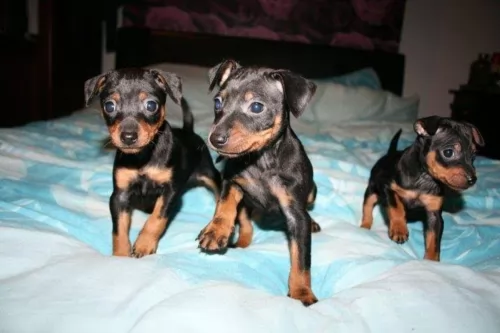 Petzlover
Petzlover Franzuskaya Bolonka is originated from France but Miniature Pinscher is originated from Germany. Both Franzuskaya Bolonka and Miniature Pinscher are having almost same height. Both Franzuskaya Bolonka and Miniature Pinscher are of same weight. Both Franzuskaya Bolonka and Miniature Pinscher has almost same life span. Franzuskaya Bolonka may have less litter size than Miniature Pinscher. Both Franzuskaya Bolonka and Miniature Pinscher requires Low Maintenance.
Franzuskaya Bolonka is originated from France but Miniature Pinscher is originated from Germany. Both Franzuskaya Bolonka and Miniature Pinscher are having almost same height. Both Franzuskaya Bolonka and Miniature Pinscher are of same weight. Both Franzuskaya Bolonka and Miniature Pinscher has almost same life span. Franzuskaya Bolonka may have less litter size than Miniature Pinscher. Both Franzuskaya Bolonka and Miniature Pinscher requires Low Maintenance.
 The Franzuskaya Bolonka in France is known as the Tsvetnaya Bolonka in Russia and in Germany as the Bolonka Zwetna. All of these translate to Colored Bolognese. It is known as the “Pride of Russia” and was rediscovered by the Russians following the thaw of the Cold War. It is also sometimes translated as a colored lapdog.
The Franzuskaya Bolonka in France is known as the Tsvetnaya Bolonka in Russia and in Germany as the Bolonka Zwetna. All of these translate to Colored Bolognese. It is known as the “Pride of Russia” and was rediscovered by the Russians following the thaw of the Cold War. It is also sometimes translated as a colored lapdog.
The Bolonka is a rare breed in the toy category with ancestors in the Bichon Friese line. This little dog looks very much like the national dog of Cuba – the Havanese. In addition to the Bichon other small dogs in this ancestral line include the Shih Tzu, Toy Poodle, and Pekingese as well as the French, Italian and German Bolonka. They are often confused with the Bolognese as both breeds appear in various countries and have many similarities.
In all countries the common name for this dog is the Bolonka. They have a variety of names and nick names depending on the country. In addition to being the “Pride of Russia” he is called a Russian colored Bichon, Czechs call it the Bareyny Bolonsky, the Germans since 1980 have called it the Bolonka Zwetna but the Nordic Kennel Union does not recognize the Zwenta only the Russian Twetnaya.
The French version is seen to be the original with its ancestry dating back to the 18th century when Russian nobles were presented with a Bolonka by Louis XIV of France, and others migrated with the army of Napoleon to Russia. They were still known as the Bolonka of France. Small dogs were not popular in Russia due to the need for dogs that could work on farms and/or hunt. Particularly during the Soviet years, they were considered unnecessary. No Bolonkas were imported to Russia during the Soviet regime, so only localized breeding took place. The goal of breeders in the Soviet Union was to develop a toy dog, lap sized with an apartment living temperament.
During the cold war the Russians sent a pair of breeding Franzuskaya Bolonka to East Germany and they began to develop the breed there as well. At the same time the colored versions of the Bolonka were being bred. The Franzuskaya Bolonka is recognized by the Verband Dur Das Deutsche Hundewesen (VDF) while the other colored breeds are not. The white Bolonka is not recognized by the Federation Cynoloqique Internationale as a breed separate from the Bolognese but as simply another version. Individual clubs throughout the world recognized one or more versions of the Bolonka. They are thought to be the rarest within the Bichon family.
Today’s Bolonka is owed by Prince William and Princess Kate, giving the breed more publicity than it has had in many years.
 The Miniature Pinscher hails from Germany. It appears to be an ancient dog breed, going back hundreds of years and being used to kill vermin.
The Miniature Pinscher hails from Germany. It appears to be an ancient dog breed, going back hundreds of years and being used to kill vermin.
He is a distinct breed and much older than the Dobermann Pinscher. Development of this small dog started way back in 1895 when the Pinscher Klub was formed. It was renamed the Pinscher-Schnauzer Klub and the first breed standard was also written.
By 1929, the Miniature Pinscher Club of America was formed.
 The Franzuskaya Bolonka is neither heavy boned nor fine boned. They are a toy breed with a moderate bone structure. The ears are neither long nor short and they have tails that touch the back at the tip. Like others in the Bichon family the Franzuskaya Bolonka does not shed. He is a sturdy little dog and the male has a distinct beard and moustache that the females of the breed do not. They have long coats that are wavy and curly. The Franzuskaya Bolonka is of course only white. The Russian version might be brown, red, black, wolf-gray, gray and of course white.
The Franzuskaya Bolonka is neither heavy boned nor fine boned. They are a toy breed with a moderate bone structure. The ears are neither long nor short and they have tails that touch the back at the tip. Like others in the Bichon family the Franzuskaya Bolonka does not shed. He is a sturdy little dog and the male has a distinct beard and moustache that the females of the breed do not. They have long coats that are wavy and curly. The Franzuskaya Bolonka is of course only white. The Russian version might be brown, red, black, wolf-gray, gray and of course white.
 This bright, alert little dog stands at 25 to 30cm and weighs in the region of 3 to 5 kg.
This bright, alert little dog stands at 25 to 30cm and weighs in the region of 3 to 5 kg.
The body is lean and muscular with strong, straight legs. He has a short, sleek coat with no undercoat. The coat is black and tan, chocolate or a rusty shade. The ears are erect but sometimes they are half erect and half floppy, the little nose is black and the tail is usually docked. If you allow your Min Pin to breed, you can expect 2 - 6 puppies.
The Min Pin is a bright, feisty, alert toy breed, full of personality and full of spunk, making him an excellent watchdog too.
He isn’t aggressive towards his human family but he is full of attitude and can be aggressive with other dogs. He may be small but he isn’t a lap dog, being way too active for that, loving to be involved in a game or going for a walk.
He is loving with his human family, but training and socialization can make him a better pet, obedient and amicable. He is intelligent too so he learns easily. He gets along well with children but only when those children have been taught to be kind ad gentle with all animals, but particularly with teeny weenies like himself.
 The Bolonka is great with kids, just avoid too intense play.
The Bolonka is great with kids, just avoid too intense play.
The Bolonka is a playful, lap dog with a lot of love to offer
Good adaptability great in the city in apartments and great in the country as well
They are very smart and love to learn. Being firm but beyond firm is also kind.
 The Miniature Pinscher is such a sporty, fun-loving, confident little dog that is also fearless for his small size.
The Miniature Pinscher is such a sporty, fun-loving, confident little dog that is also fearless for his small size.
He thinks he is a ferocious, big Dobermann Pinscher at heart and is ready to guard and protect his family with everything he’s got.
He is full of energy too and always ready for his daily walk and other forms of exercise and games.
He may be small, but he doesn’t want to be a lap dog, as he is too active for that. He can be highly entertaining and he promises to make you the most devoted and loving little family pet.
 Medical issues are not fully documented because of the rarity of the breed and the years of isolation in the Soviet Union.
Medical issues are not fully documented because of the rarity of the breed and the years of isolation in the Soviet Union.
 Min Pins are robust little dogs and can enjoy good health when looked after properly. They can reach 15 years of age and even more.
Min Pins are robust little dogs and can enjoy good health when looked after properly. They can reach 15 years of age and even more.
Just like with any other dogs though, they’re prone to certain health conditions. Your Miniature Pinscher is highly unlikely to get any of these diseases, but it's good to be aware of some of them.
Progressive Retinal Atrophy, known as PRA for short is an eye disease where there is gradual deterioration of the retina. You will no doubt see your dog being affected with night blindness – not being able to find their way around as they usually do.
Legg-Calve-Perthes Disease is a hip joint problem that often affects toy breeds. The blood supply to the head of the femur is decreased and you’ll notice your pet limping. It’s not an ailment reserved for old dogs either but can be found in puppies that are just 4 months of age.
Hypothyroidism is a disorder of the thyroid gland and can lead to skin conditions with your dog as well as lethargy, hair loss and obesity.
 Feed at least 3 meals a day. Feed one fourth of a cup daily split into three meals of a high quality puppy food.
Feed at least 3 meals a day. Feed one fourth of a cup daily split into three meals of a high quality puppy food.
Feed at least 2 meals per day. Feed one half of a cup daily split into two meals of a high quality dry food.
Fairly healthy breed due to isolation during cold war
The Franzuskaya Bolonka is developed as a lap dog but that does not mean he doesn’t need daily exercise. He loves to play but play gently and not for any length of time. They like to chase balls, play hide and seek and any tricks you want to teach them.
 Grooming is easy and you will simply need to brush him twice a week as his coat is short and smooth. There is really no need to bath the Min Pin and you could even take a damp cloth and wipe him down to avoid using a shampoo which could dry the skin.
Grooming is easy and you will simply need to brush him twice a week as his coat is short and smooth. There is really no need to bath the Min Pin and you could even take a damp cloth and wipe him down to avoid using a shampoo which could dry the skin.
Always check his eyes and ears for infection and check for fleas and ticks too. His nails will need to be trimmed, more so if he doesn’t wear them down naturally.
Check your dogs teeth. Small dogs are more prone to dental disease and you want to brush his teeth 2 or 3 times a week with special canine toothbrush and toothpaste to avoid dental problems.
The amount your Miniature Pinscher eats will be determined by his age and his activity levels.
When you buy commercially manufactured food, you will need to buy food that is recommended for small, energetic dogs. You don’t want to feed your pet dry kibble day after day, so a tasty, nutritious treat is to add finely chopped up boiled chicken, brown rice of pasta and some cooked vegetables such as potatoes, carrots and spinach into his kibble.
All dogs, but particularly little dogs, love simple food that is consistent like what has been mentioned. They don’t do well on strange, exotic kinds of foods as it upsets the stomach. Make sure he has cool, fresh water available to him at all times, night and day.